Characteristics of the Properties of Absodan Plus Sorbent and Its Ability to Remove Phosphates and Chromates from Aqueous Solutions
Abstract
:1. Introduction
2. Materials and Methods
2.1. Adsorbent
2.1.1. Characteristics of Absodan Plus
2.1.2. Analysis of Absodan Plus Properties
- X-ray diffraction analysis (XRD): The mineral composition of diatomite was assessed using X-ray diffraction with CuKα1 radiation, with scan step 0.015 degrees, scan rate 2 s/step, and scan range from 17 to 70° 2θ at 40 kV and 40 mA (Bruker D8 Advance, Bruker AXS, Germany). The average crystallite sizes (D) of samples were calculated from the XRD data by applying the Debye–Scherrer Equation: D = 0.89λ/BcosΘ, where λ is the wavelength of the X-ray in nanometres, B is the peak width at half-height (FWHM), and θ is the angle between the incident and diffracted beams in angular degrees.
- Crystallinity and amorphous % of diatomite from its scan were computed with Bruker Eva software, as follows:% Amorphous = ((Global area − Reduced area)/Global area) × 100
% Crystallinity = 100 − % Amorphous. - SEM microscopic analysis: The morphological and textural observation of the surface was made by scanning electron microscope (SEM) (TESCAN VEGA 3, Fuveau France). SEM was used also with a back-scattered electron detector (BSE) (INCA x-act, Oxford Instruments) to broaden the scope of the element content analysis.
- Brunauer-Emmett-Teller (BET) surface area analysis: Specific surface area and total pore volume were determined using low-temperature nitrogen adsorption-desorption isotherms using an ASAP 2020 porosimeter (Micromeritics, Norcross, GA, USA). Before measurements, the samples were degassed at 200 °C. The specific surface area and total pore volume were calculated by the Brunauer-Emmett-Teller (BET) method and the Barrett-Joyner-Halenda (BJH) method, respectively.
- Stereoscopic image of the diatomite was analyzed by X2000 series microscopes (Opta-Tech, Warsaw, Poland) are designed for observation of small, 3D objects in transmitted and reflected light, and the 2D surface of diatomite measurements of topography, and layer thickness were carried out by confocal 3D microscope (NanoFocus, Oberhausen, Germany).
- Fourier transform infrared spectroscopy (FTIR) analysis: FTIR spectra of Absodan Plus were obtained with an Alpha spectrometer (Bruker, Billerica, MA, USA). The tests were carried out with the transmission method, using the technique of pressing samples with potassium bromide. Compressed adsorbent samples were mixed with KBr at a constant adsorbent weight to KBr weight ratio of 0.25% and pelleted under pressure. The FTIR spectra were employed in a spectral range of 4000 to 500 cm−1 [58].
- Determination of point of zero charge (PZC) of diatomite: The PZC was determined using three methods:
- Suspension method: In a series of 250-mL Erlenmeyer flasks, 0.5 g of diatomite was added to 50.0 mL of 0.1 M NaNO3 solution. The pH was adjusted with 0.1 M HNO3 and 0.1 M NaOH as needed, to obtain the appropriate pH values of 2, 3, 4, 5, 6, 7, 8, 9, 10, and 11. The samples were shaken for 12 h using a shaker: vibration amplitude 8.5; rate 180 (ELPIN PLUS, type 358 A, Lubawa, Poland). After settling, the pH values of the supernatant in each flask were again measured. After settling, the pH values of the supernatant in each flask were again measured [59,60].
- Potentiometric method: Three flasks containing 0.05 g of diatomite, 3 mL of 0.1 M NaNO3 (to establish an ionic strength constant), and 1 mL of 0.01 M NaOH were added to 6 mL of distilled water. Then all samples were titrated with 0.01 M HCl. Based on the obtained data, a plot of the dependence of the potential change [mV] on the volume of titrant consumed [mL] was made. The research was carried out for a blank and a test sample. The diatomite potential was measured using a combination glass electrode (Elmetron, type OSH 10-00, Zabrze, Poland) [59,60].
- Hahn’a Method: The method consists in determining the highest increase of the potential (∆Emax) and two adjacent potential values that lie on both sides of it (∆E1, ∆E2). Based on these values, the correction (xb) is calculated, which increases the accuracy of the PZC determination (the correction enables the precise determination of the volume of the titrant at the place of its occurrence [61]. The calculations were done according to Equation (1):where:
- xb—correction,
- ∆V—a volume of titrant,
- ∆E1—a potential gain that occurs before ∆Emax.
2.2. Adsorbate
- Determination of the concentration of phosphates ions by the molybdenum blue method: The standard curve was prepared based on a series of phosphates ions solutions with concentrations ranging from 0 to 1.7 mg/L. The absorbance of the prepared solutions was measured against the reagent blank (sample without the addition of phosphates ions). Immediately before the measurement, 1.5 mL of ammonium molybdate and 2 drops of tin (II) chloride (reducing agent in the reaction of the formation of navy blue molybdenum blue) were added to each of the samples. Because the molybdenum method cannot determine strongly acidic or basic aqueous solutions, all samples were neutralized by adding six drops of 6 M NaOH each. The standard curve equation was determined by linear regression using the least-squares method. The determined proper absorption coefficient (ε), corresponding to the slope in the straight line equation, was 0.28 L/mg·cm (Figure 1a).
- Determination of the concentration of chromates ions by the chromate method (UV/VIS spectrophotometry): Absorbance measurements were performed for given standard solutions with known concentrations in the range of 0 to 35 mg/L. The absorbance of the prepared solutions was measured against the blank reagent (a sample without the addition of chromates ions. The determined proper absorption coefficient (ε) was 0.03 L/mg·cm (Figure 1b).
2.3. Batch Studies of the Adsorption Process
2.3.1. Effect of Shaking Time on Adsorption
2.3.2. Effect of Adsorbent Concentration on Adsorption
2.4. Models of Equilibrium and Kinetics of Adsorption
3. Results and Discussion
3.1. Adsorbent Characteristics
3.2. The Adsorption Equilibrium
- RL—partition coefficient;
- aL—the quotient of the equilibrium constant for the isotherm and the maximum area coverage for the model.
3.3. The Adsorption Kinetics
4. Conclusions
Author Contributions
Funding
Institutional Review Board Statement
Informed Consent Statement
Data Availability Statement
Conflicts of Interest
References
- Kazakis, N.; Kantiranis, N.; Kalaitzidou, K.; Kaprara, E.; Mitrakas, M.; Frei, R.; Vargemezis, G.; Tsourlos, P.; Zouboulis, A.; Filippidis, A. Origin of hexavalent chromium in groundwater: The example of Sarigkiol Basin, Northern Greece. Sci. Total Environ. 2017, 593–594, 552–566. [Google Scholar] [CrossRef] [PubMed]
- Boujelben, R.; Ellouze, M.; Aziz, F.; Ouazzani, N.; Sayadi, S. Box-Behnken approach for optimization of Cr(III) removal from a real tanning effluent using powdered marble. Int. J. Environ. Sci. Technol. 2022, 19, 4305–4320. [Google Scholar] [CrossRef]
- Tumolo, M.; Ancona, V.; De Paola, D.; Losacco, D.; Campanale, C.; Massarelli, C.; Uricchio, V.F. Chromium Pollution in European Water, Sources, Health Risk, and Remediation Strategies: An Overview. Int. J. Environ. Res. Public Health 2020, 17, 5438. [Google Scholar] [CrossRef] [PubMed]
- Chen, S.-S.; Cheng, C.-Y.; Li, C.-W.; Chai, P.-H.; Chang, Y.-M. Reduction of chromate from electroplating wastewater from pH 1 to 2 using fluidized zero valent iron process. J. Hazard. Mater. 2007, 142, 362–367. [Google Scholar] [CrossRef] [PubMed]
- Castro, L.; Rocha, F.; Muñoz, J.Á.; González, F.; Blázquez, M.L. Batch and Continuous Chromate and Zinc Sorption from Electroplating Effluents Using Biogenic Iron Precipitates. Minerals 2021, 11, 349. [Google Scholar] [CrossRef]
- Chowdhury, M.; Mostafa, M.G.; Biswas, T.K.; Mandal, A.; Saha, A.K. Characterization of the Effluents from Leather Processing Industries. Environ. Process. 2015, 2, 173–187. [Google Scholar] [CrossRef] [Green Version]
- Genawi, N.M.; Ibrahim, M.H.; El-Naas, M.H.; Alshaik, A.E. Chromium Removal from Tannery Wastewater by Electrocoagulation: Optimization and Sludge Characterization. Water 2020, 12, 1374. [Google Scholar] [CrossRef]
- Mamun, A.A.; Khin, M.M.; Granata, G.; Tokoro, C. Removal of chromate from tannery wastewater: The applicability of sulfate-green rust in real coprecipitation processes. Resour. Process. 2018, 65, 67–73. [Google Scholar] [CrossRef] [Green Version]
- Dresel, P.E.; Qafoku, N.; McKinley, J.P.; Fruchter, J.S.; Ainsworth, C.C.; Liu, C.; Ilton, E.S.; Phillips, J.L. Geochemical Characterization of Chromate Contamination in the 100 Area Vadose Zone at the Hanford Site; Pacific Northwest National Lab. (PNNL): Richland, WA, USA, 2008.
- Wanner, C.; Eggenberger, U.; Kurz, D.; Zink, S.; Mäder, U. A chromate-contaminated site in southern Switzerland—Part 1: Site characterization and the use of Cr isotopes to delineate fate and transport. Appl. Geochem. 2012, 27, 644–654. [Google Scholar] [CrossRef]
- Ulén, B.; Bechmann, M.; Fölster, J.; Jarvie, H.P.; Tunney, H. Agriculture as a phosphorus source for eutrophication in the north-west European countries, Norway, Sweden, United Kingdom and Ireland: A review. Soil Use Manag. 2007, 23, 5–15. [Google Scholar] [CrossRef]
- Nortjé, G.P.; Laker, M.C. Factors That Determine the Sorption of Mineral Elements in Soils and Their Impact on Soil and Water Pollution. Minerals 2021, 11, 821. [Google Scholar] [CrossRef]
- Source Apportionment of Nitrogen and Phosphorus Inputs into the Aquatic Environment; European Environment Agency Report No 7/2005; Office for Official Publications of the European Communities: Luxembourg, 2005.
- Bunce, J.T.; Ndam, E.; Ofiteru, I.D.; Moore, A.; Graham, D.W. A Review of Phosphorus Removal Technologies and Their Applicability to Small-Scale Domestic Wastewater Treatment Systems. Front. Environ. Sci. 2018, 6, 8. [Google Scholar] [CrossRef] [Green Version]
- Andreo-Martínez, P.; García-Martínez, N.; Almela, L. Domestic Wastewater Depuration Using a Horizontal Subsurface Flow Constructed Wetland and Theoretical Surface Optimization: A Case Study under Dry Mediterranean Climate. Water 2016, 8, 434. [Google Scholar] [CrossRef] [Green Version]
- Kuo, Y.-M.; Muñoz-Carpena, R. Simplified modeling of phosphorus removal by vegetative filter strips to control runoff pollution from phosphate mining areas. J. Hydrol. 2009, 378, 343–354. [Google Scholar] [CrossRef]
- Villalba, G.; Liu, Y.; Schroder, H.; Ayres, R.U. Global Phosphorus Flows in the Industrial Economy From a Production Perspective. J. Ind. Ecol. 2008, 12, 557–569. [Google Scholar] [CrossRef]
- Grzmil, B.; Wronkowski, J. Removal of phosphates and fluorides from industrial wastewater. Desalination 2006, 189, 261–268. [Google Scholar] [CrossRef]
- Khaled, B.; Wided, B.; Béchir, H.; Elimame, E.; Mouna, L.; Zied, T. Investigation of electrocoagulation reactor design parameters effect on the removal of cadmium from synthetic and phosphate industrial wastewater. Arab. J. Chem. 2019, 12, 1848–1859. [Google Scholar] [CrossRef]
- Karn, R.; Ojha, N.; Abbas, S.; Bhugra, S. A review on heavy metal contamination at mining sites and remedial techniques. IOP Conf. Ser. Earth Environ. Sci. 2021, 796, 012013. [Google Scholar] [CrossRef]
- Li, T.; Dong, W.; Zhang, Q.; Xing, D.; Ai, W.; Liu, T. Phosphate removal from industrial wastewater through in-situ Fe2+ oxidation induced homogenous precipitation: Different oxidation approaches at wide-ranged pH. J. Envir. Manag. 2020, 255, 109849. [Google Scholar] [CrossRef]
- Minas, F.; Chandravanshi, B.S.; Leta, S. Chemical Precipitation Method For Chromium Removal And Its Recovery From Tannery Wastewater In Ethiopia. Chem. Int. 2017, 3, 291–305. [Google Scholar]
- Omor, A.; Oubenali, A.A.; Oulbacha, M.; Majbar, Z.; Indrissi, N.; Elmadani, F.Z.; Metarfi, Y.; Ben Abbou, M.; Rais, Z. Environmental risk analysis of a dechromating station of chromate waste water. J. Appl. Sci. Environ. Stud. 2018, 1, 74–82. [Google Scholar]
- Peng, H.; Leng, Y.; Cheng, Q.; Shang, Q.; Shu, J.; Guo, J. Efficient Removal of Hexavalent Chromium from Wastewater with Electro-Reduction. Processes 2019, 7, 41. [Google Scholar] [CrossRef] [Green Version]
- Plummer, S.; Gorman, C.; Henrie, T.; Shimabuku, K.; Thompson, R.; Seidel, C. Optimization of strong-base anion exchange O&M costs for hexavalent chromium treatment. Water Res. 2018, 139, 420–433. [Google Scholar] [PubMed]
- Kan, C.-C.; Ibe, A.H.; Rivera, K.K.P.; Arazo, R.O.; de Luna, M.D.G. Hexavalent chromium removal from aqueous solution by adsorbents synthesized from groundwater treatment residuals. Sustain. Environ. Res. 2017, 27, 163–171. [Google Scholar] [CrossRef]
- Wang, J.; Zhang, G.; Qiao, S.; Zhou, J. Magnetic Fe0/iron oxide-coated diatomite as a highly efficient adsorbent for recovering phosphorus from water. Chem. Eng. J. 2021, 412, 128696. [Google Scholar] [CrossRef]
- Wang, Z.; Lin, Y.; Wu, D.; Kong, H. Hydrous iron oxide modified diatomite as an active filtration medium for phosphate capture. Chemosphere 2016, 144, 1290–1298. [Google Scholar] [CrossRef]
- Alemayehu, E.; Thiele-Bruhn, S.; Lennartz, B. Adsorption behaviour of Cr (VI) onto macro and micro-vesicular volcanic rocks from water. Sep. Purif. Technol. 2011, 78, 55–61. [Google Scholar] [CrossRef]
- Memedi, H.; Atkovska, K.; Lisichkov, K.; Marinkovski, M.; Kuvendziev, S.; Bozinovski, Z.; Reka, A.A. Removal of Cr (VI) From Water Resources by Using Different Raw Inorganic Sorbents. Qual. Life 2016, 14, 77–85. [Google Scholar] [CrossRef] [Green Version]
- Zhang, B.; Wang, X.; Li, S.; Liu, Y.; An, Y.; Zheng, X. Preferable Adsorption of Nitrogen and Phosphorus from Agricultural Wastewater Using Thermally Modified Zeolite–Diatomite Composite Adsorbent. Water 2019, 11, 2053. [Google Scholar] [CrossRef] [Green Version]
- Gubernat, S.; Masłoń, A.; Czarnota, J.; Koszelnik, P. Reactive Materials in the Removal of Phosphorus Compounds from Wastewater—A Review. Materials 2020, 13, 3377. [Google Scholar] [CrossRef]
- Aljbour, S.H.; Al-Harahsheh, A.M.; Aliedeh, M.A.; Al-Zboon, K.; Al-Harahsheh, S. Phosphate removal from aqueous solutions by using natural Jordanian zeolitic tuff. Adsorp. Sci. Technol. 2017, 35, 284–299. [Google Scholar] [CrossRef] [Green Version]
- Haldar, S.K.; Tišljar, J. Introduction to Mineralogy and Petrology; Elsevier: Amsterdam, The Netherlands, 2014. [Google Scholar]
- Reka, A.A.; Pavlovski, B.; Fazlija, E.; Berisha, A.; Pacarizi, M.; Daghmehchi, M.; Sacalis, C.; Jovanovski, G.; Makreski, P.; Oral, A. Diatomaceous Earth: Characterization, thermal modification, and application. Open Chem. 2021, 19, 451–461. [Google Scholar] [CrossRef]
- Figarska-Warchoł, B.; Stańczak, G.; Rembiś, M.; Toboła, T. Diatomaceous rocks of the Jawornik deposit (the Polish Outer Carpathians)-petrophysical and petrographical evaluatio. Geol. Geophys. Environ. 2015, 41, 311–331. [Google Scholar] [CrossRef]
- Zahradník, J.; Jirásek, J.; Zahradník, J.; Sivek, M. Development of the diatomite production, reserves and its processing in the Czech Republic in 1999–2018. Miner. Resour. Manag. 2019, 35, 31–48. [Google Scholar]
- Zhao, Y.; Tian, G.; Duan, X.; Liang, X.; Meng, J.; Liang, J. Environmental Applications of Diatomite Minerals in Removing Heavy Metals from Water. Ind. Eng. Chem. Res. 2019, 58, 11638–11652. [Google Scholar] [CrossRef]
- Hernández-Ávila, J.; Salinas-Rodríguez, E.; Cerecedo-Sáenz, E.; Reyes-Valderrama, M.; Arenas-Flores, A.; Román-Gutiérrez, A.; Rodríguez-Lugo, V. Diatoms and Their Capability for Heavy Metal Removal by Cationic Exchange. Metals 2017, 7, 169. [Google Scholar] [CrossRef]
- Benkacem, T.; Hamdi, B.; Chamayou, A.; Balard, H.; Calvet, R. Physicochemical characterization of a diatomaceous upon an acid treatment: A focus on surface properties by inverse gas chromatography. Powder Technol. 2016, 294, 498–507. [Google Scholar] [CrossRef] [Green Version]
- Bandura, L.; Woszuk, A.; Kołodyńska, D.; Franus, W. Application of Mineral Sorbents for Removal of Petroleum Substances: A Review. Minerals 2017, 7, 37. [Google Scholar] [CrossRef] [Green Version]
- Kaleta, J.; Papciak, D.; Puszkarewicz, A. Klinoptylolity i diatomity w aspekcie przydatności w uzdatnianiu wody i oczyszczaniu ścieków. Gospod. Surowcami Miner. 2007, 23, 21–34. (In Polish) [Google Scholar]
- Zamorska, J.; Papciak, D. Activity of nitrifying biofilm in the process of water treatment in diatomite bed. Environ. Prot. Eng. 2008, 34, 37–52. [Google Scholar]
- Yuan, P.; Wu, D.Q.; He, H.P.; Lin, Z.Y. The hydroxyl species and acid sites on diatomite surface: A combined IR and Raman study. Appl. Surf. Sci. 2004, 227, 30–39. [Google Scholar] [CrossRef] [Green Version]
- Bello, O.S.; Adegoke, K.A.; Oyewole, R.O. Insights into the Adsorption of Heavy Metals from Wastewater using Diatomaceous Earth. Sep. Sci. Technol. 2014, 49, 1787–1806. [Google Scholar] [CrossRef]
- Danil de Namor, A.F.; El Gamouz, A.; Frangie, S.; Martinez, V.; Valiente, L.; Webb, O.A. Turning the volume down on heavy metals using tuned diatomite. A review of diatomite and modified diatomite for the extraction of heavy metals from water. J. Hazard. Mater. 2012, 241–242, 14–31. [Google Scholar] [CrossRef] [PubMed]
- Zhang, J.; Ding, T.; Zhang, Z.; Xu, L.; Zhang, C. Enhanced Adsorption of Trivalent Arsenic from Water by Functionalized Diatom Silica Shells ed W-C Chin. PLoS ONE 2015, 10, e0123395. [Google Scholar] [CrossRef]
- Puszkarewicz, A.; Kaleta, J. Adsorption of Chromium (VI) on Raw and Modified Carpathian Diatomite. J. Ecol. Eng. 2019, 20, 11–17. [Google Scholar] [CrossRef]
- Sungworawongpana, S.; Pengprecha, S. Calcination Effect of Diatomite to Chromate Adsorption. Procedia Eng. 2011, 8, 53–57. [Google Scholar] [CrossRef] [Green Version]
- Selim, A.Q.; Mohamed, E.A.; Mobarak, M.; Zayed, A.M.; Seliem, M.K.; Komarneni, S. Cr (VI) uptake by a composite of processed diatomite with MCM-41: Isotherm, kinetic and thermodynamic studies. Microporous Mesoporous Mater. 2018, 260, 84–92. [Google Scholar] [CrossRef]
- An Investigation of the Sorption of Arsenic by Diatomite (WC/99/020). Available online: https://www.gov.uk/research-for-development-outputs/an-investigation-of-the-sorption-of-arsenic-by-diatomite-wc-99-020 (accessed on 12 March 2022).
- Eynard, U.; Georgitzikis, K.; Wittmer, D.; Latunussa, C.E.L.; Torres de Matos, C.; Mancini, L.; Unguru, M.; Blagoeva, D.; Bobba, S.; Pavel, C.; et al. 2020 European Commission, Study on the EU’s List of Critical Raw Materials (2020)—Final Report (2020); Publications Office of the European Union: Luxembourg, 2020. [Google Scholar]
- Commercial Data of Granular Diatomite DETM. Available online: https://epminerals.com/products/oil-absorbent-de (accessed on 12 March 2022).
- Commercial Data of Granular Diatomite Damolex, C. Available online: https://mistralni.co.uk/products/diatomaceous-earth-granular-diatomite-damolex-c-1-3mm (accessed on 12 March 2022).
- Commercial Data of Granular Diatomite Absodan Plus. Available online: https://www.damolin.com.pl/pl/p/Sorbent-ABSODAN-Plus-DAMOLIN-worek-10-Kg/175 (accessed on 12 March 2022).
- ElSayed, E.E. Natural diatomite as an effective adsorbent for heavy metals in water and wastewater treatment (a batch study). Water Sci. 2018, 32, 32–43. [Google Scholar] [CrossRef] [Green Version]
- Datta, J. Stiffness and energy dissipation of poly(etherurethane) resilient elements. Chem. Rev. 2015, 1, 116–119. (In Polish) [Google Scholar] [CrossRef]
- Sočo, E.; Papciak, D.; Michel, M.M.; Pająk, D.; Domoń, A.; Kupiec, B. Characterization of the Physical, Chemical, and Adsorption Properties of Coal-Fly-Ash–Hydroxyapatite Composites. Minerals 2021, 11, 774. [Google Scholar] [CrossRef]
- Markmanuel, D.; Tarawou, T.; Horsfall, M. Determination of Sodium Sorption Capacity Using the Boehm Metho Research. J. Chem. Sci. 2013, 3, 1–4. [Google Scholar]
- Pretoriusa, P.J.; Woolardb, C.D. The Surface Chemical Properties of Novel High Surface Area Solids Synthesized from Coal Fly Ash. S. Afr. J. Chem. 2003, 56, 34–39. [Google Scholar]
- Fiol, N.; Villaescusa, I. Determination of sorbent point zero charge: Usefulness in sorption studies. Environ. Chem. Lett. 2009, 7, 79–84. [Google Scholar] [CrossRef]
- Al-Ghouti, M.A.; Da’ana, D.A. Guidelines for the use and interpretation of adsorption isotherm models: A review. J. Hazard. Mater. 2020, 393, 122383. [Google Scholar] [CrossRef] [PubMed]
- Weber, W.J.J.; Morris, J.C. Kinetics of adsorption on carbon from solution. J. Sanit. Eng. Div. 1963, 89, 31–59. [Google Scholar] [CrossRef]
- Freundlich, H.M.F. Over the Adsorption in Solution. J. Phys. Chem. 1906, 57, 385–471. [Google Scholar]
- Liu, X.; Zhang, L. Removal of phosphate anions using the modified chitosan beads: Adsorption kinetic, isotherm and mechanism studies. Powder Technol. 2015, 277, 112–119. [Google Scholar] [CrossRef]
- Langmuir, I. The constitution and fundamental properties of solids and liquids. Part I. solids. J. Am. Chem. Soc. 1916, 38, 2221–2295. [Google Scholar] [CrossRef] [Green Version]
- Qu, B.; Zhou, J.; Xiang, X.; Zheng, C.; Zhao, H.; Zhou, X. Adsorption behavior of Azo Dye C. I. Acid Red 14 in aqueous solution on surface soils. J. Environ. Sci. 2008, 20, 704–709. [Google Scholar] [CrossRef]
- Jovanovich, D.S. Physical adsorption of gases I: Isotherms for monolayer and multilayer adsorption. Colloid Polym. Sci. 1969, 235, 1203–1214. [Google Scholar]
- Halsey, G.D. The Role of Surface Heterogeneity in Adsorption. Adv. Catal. 1952, 4, 259–269. [Google Scholar]
- Gholitabar, S.; Tahermansouri, H. Kinetic and multi-parameter isotherm studies of picric acid removal from aqueous solutions by carboxylated multi-walled carbon nanotubes in the presence and absence of ultrasound. Carbon Lett. 2017, 22, 14–24. [Google Scholar]
- Reczek, L.; Michel, M.M.; Trach, Y.; Siwiec, T.; Tytkowska-Owerko, M. The Kinetics of Manganese Sorption on Ukrainian Tuff and Basalt—Order and Diffusion Models Analysis. Minerals 2020, 10, 1065. [Google Scholar] [CrossRef]
- Mozgawa, W.; Król, M.; Bajda, T. Application of IR spectra in the studies of heavy metal cations immobilization on natural sorbents. J. Mol. Struct. 2009, 924–926, 427–433. [Google Scholar] [CrossRef]
- Almasri, D.A.; Saleh, N.B.; Atieh, M.A.; McKay, G.; Ahzi, S. Adsorption of phosphate on iron oxide doped halloysite nanotubes. Sci. Rep. 2019, 9, 3232. [Google Scholar] [CrossRef]
- Shabalala, A.N.; Basitere, M. Interactive Relationship between Cementitious Materials and Acid Mine Drainage: Their Effects on Chromium Cr(VI) Removal. Minerals 2020, 10, 932. [Google Scholar] [CrossRef]
- Mishima, K.; Du, X.; Sekiguchi, S.; Kano, N. Experimental and Theoretical Studies on the Adsorption and Desorption Mechanisms of Chromate Ions on Cross-Linked Chitosan. J. Funct. Biomater. 2017, 8, 51. [Google Scholar] [CrossRef] [Green Version]
- Ojediran, J.O.; Dada, A.O.; Aniyi, S.O.; David, R.O.; Adewumi, A.D. Mechanism and isotherm modeling of effective adsorption of malachite green as endocrine disruptive dye using Acid Functionalized Maize Cob (AFMC). Sci. Rep. 2021, 11, 21498. [Google Scholar] [CrossRef]
- Wu, Y.; Li, X.; Yang, Q.; Wang, D.; Xu, Q.; Yao, F.; Chen, F.; Tao, Z.; Huang, X. Hydrated lanthanum oxide-modified diatomite as highly efficient adsorbent for low-concentration phosphate removal from secondary effluents. J. Environ. Manag. 2019, 231, 370–379. [Google Scholar] [CrossRef]
- Liu, J.; Zhu, R.; Ma, L.; Fu, H.; Lin, X.; Parker, S.C.; Molinari, M. Adsorption of phosphate and cadmium on iron (oxyhydr)oxides: A comparative study on ferrihydrite, goethite, and hematite. Geoderma 2021, 383, 114799. [Google Scholar] [CrossRef]
- Elzinga, E.J.; Sparks, D.L. Phosphate adsorption onto hematite: An in situ ATR-FTIR investigation of the effects of pH and loading level on the mode of phosphate surface complexation. J. Colloid Interface Sci. 2007, 308, 53–70. [Google Scholar] [CrossRef]
- Wang, L.; Putnis, C.; Hövelmann, J.; Putnis, A. Interfacial Precipitation of Phosphate on Hematite and Goethite. Minerals 2018, 8, 207. [Google Scholar] [CrossRef] [Green Version]
- Ajouyed, O.; Hurel, C.; Ammari, M.; Allal, L.B.; Marmier, N. Sorption of Cr(VI) onto natural iron and aluminum (oxy)hydroxides: Effects of pH, ionic strength and initial concentration. J. Hazard. Mater. 2010, 174, 616–622. [Google Scholar] [CrossRef]
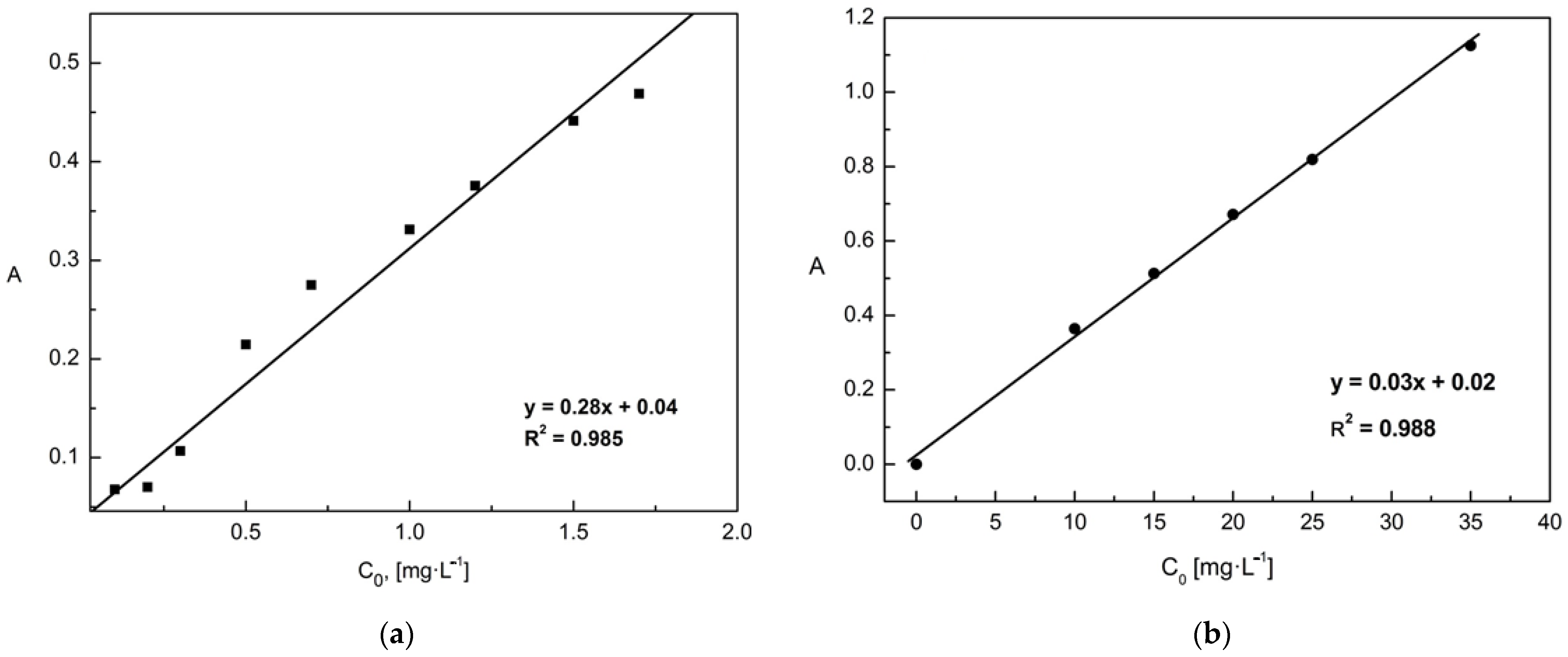
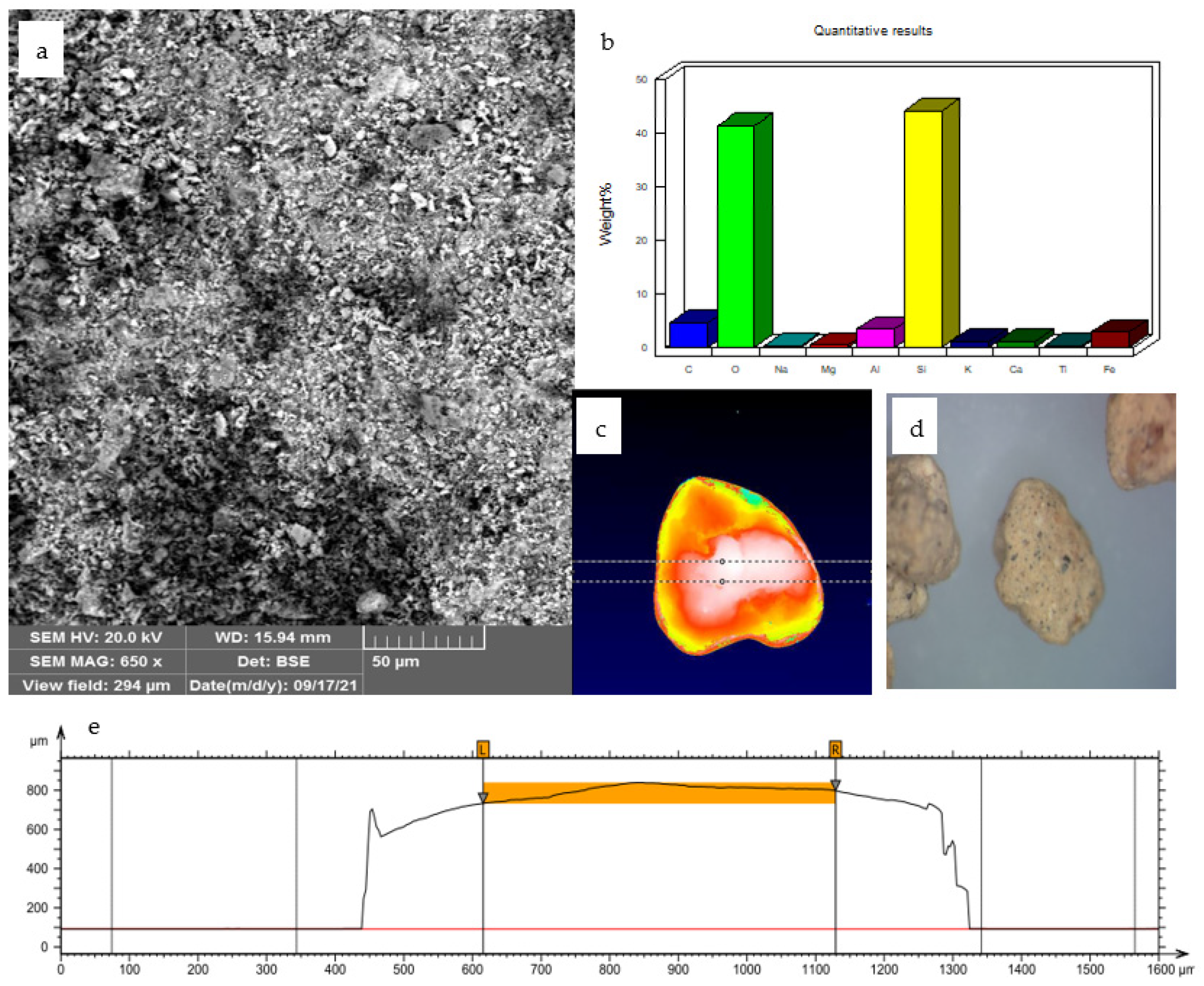
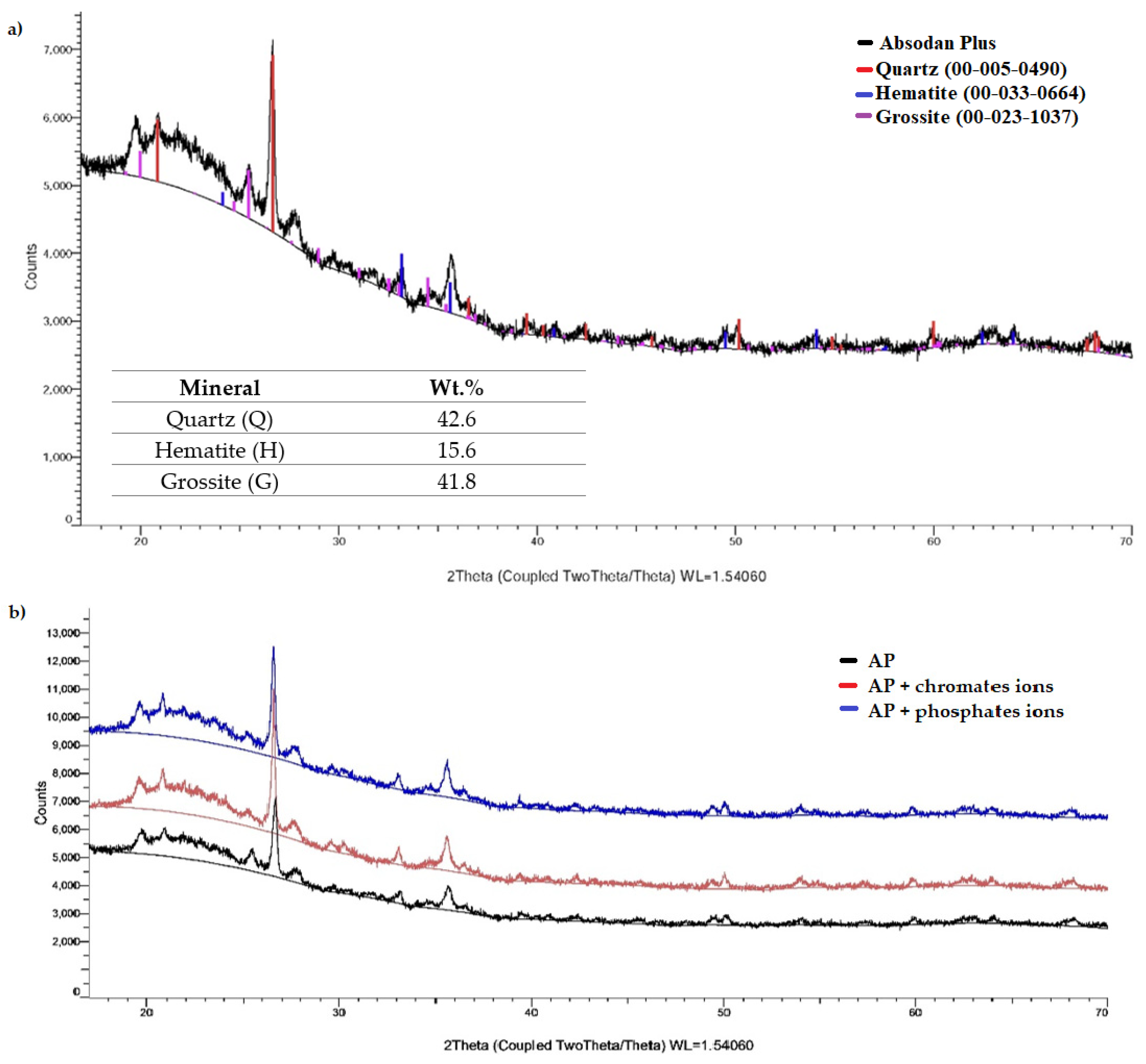
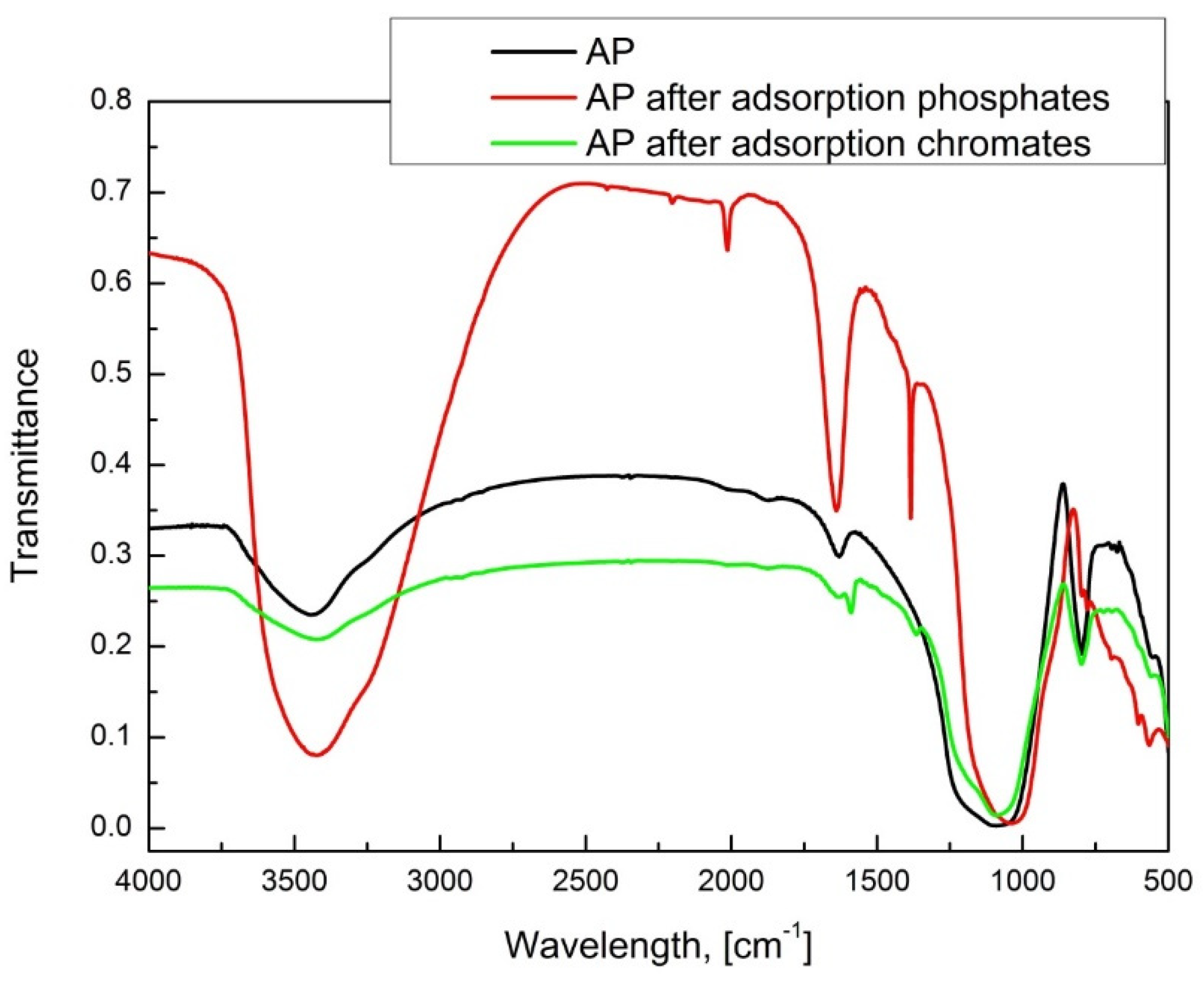
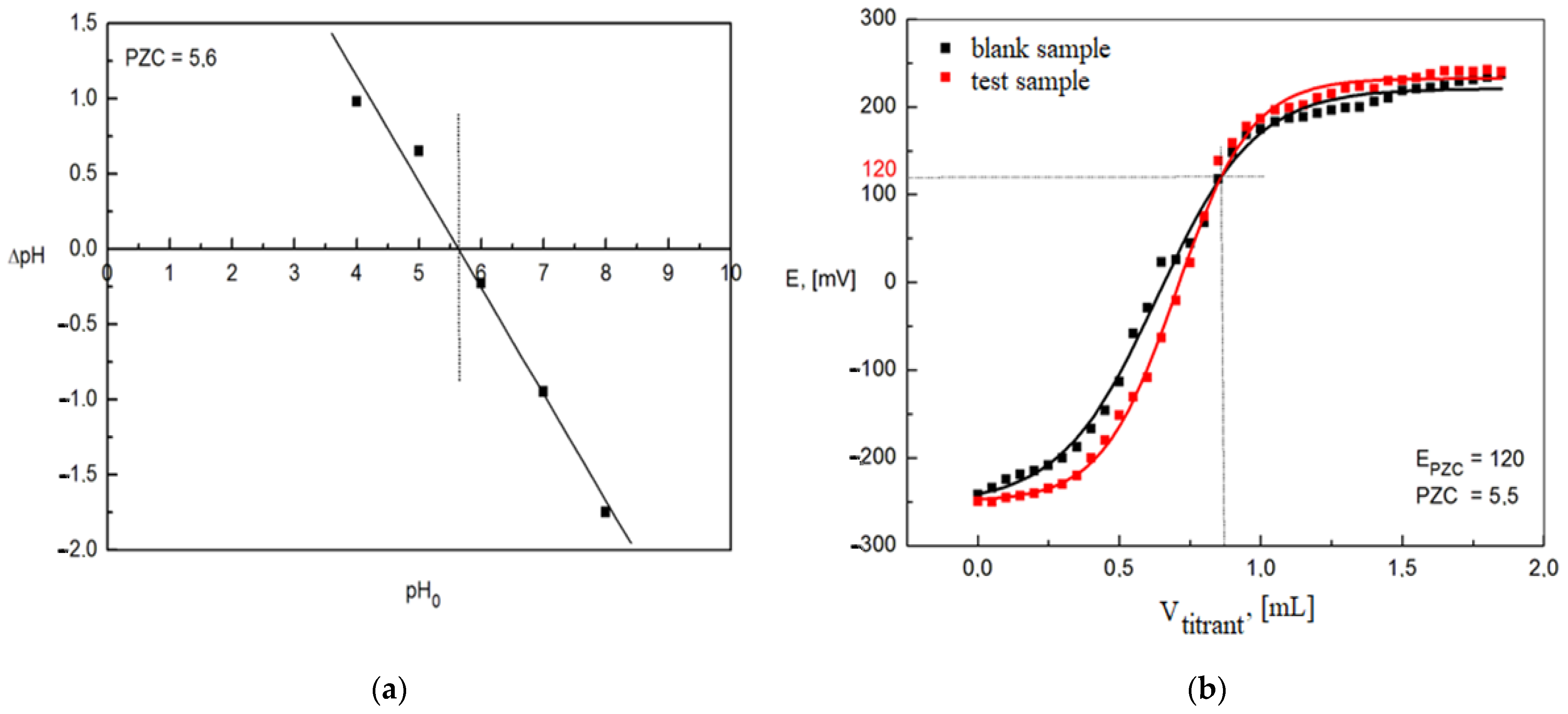
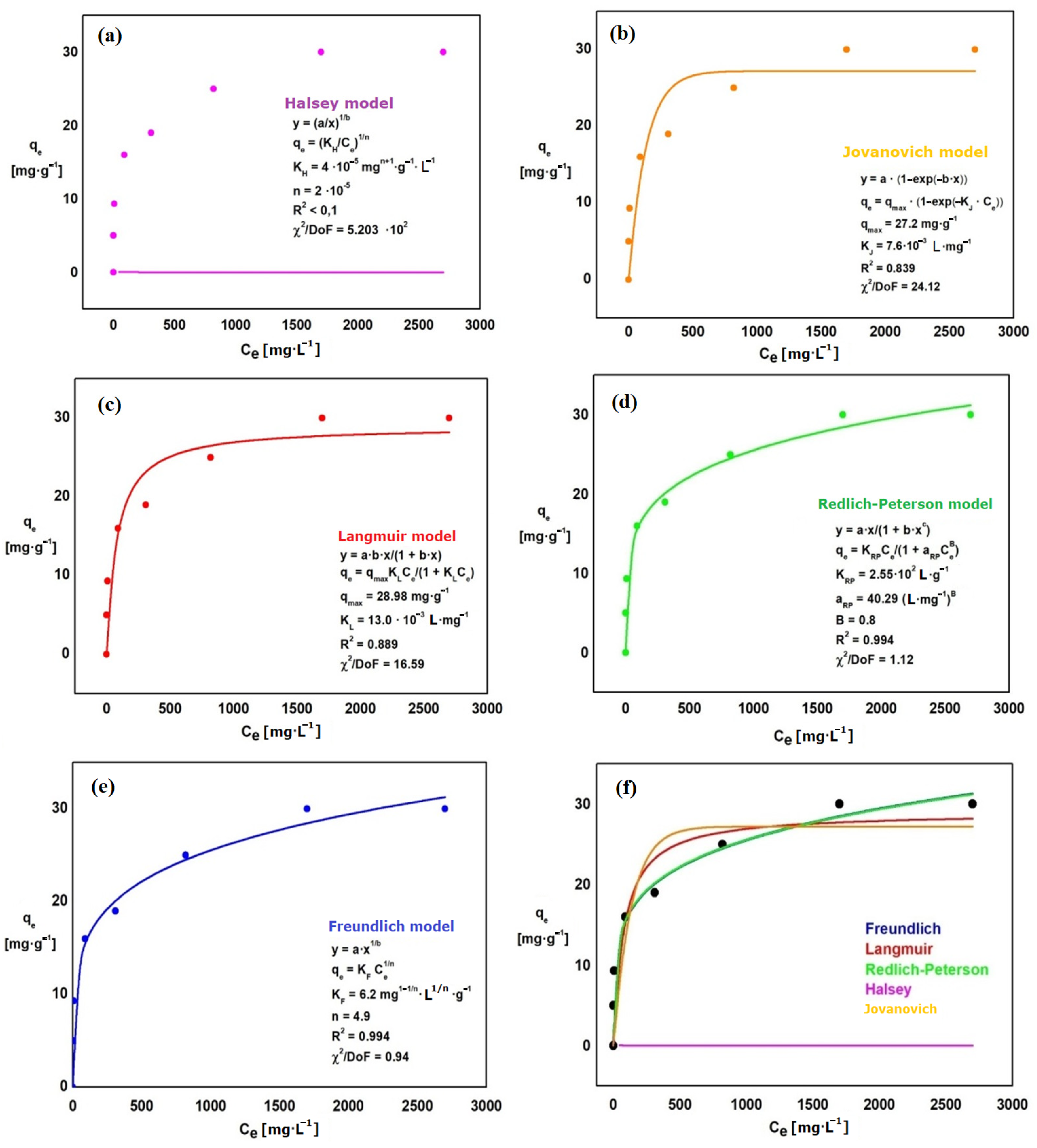

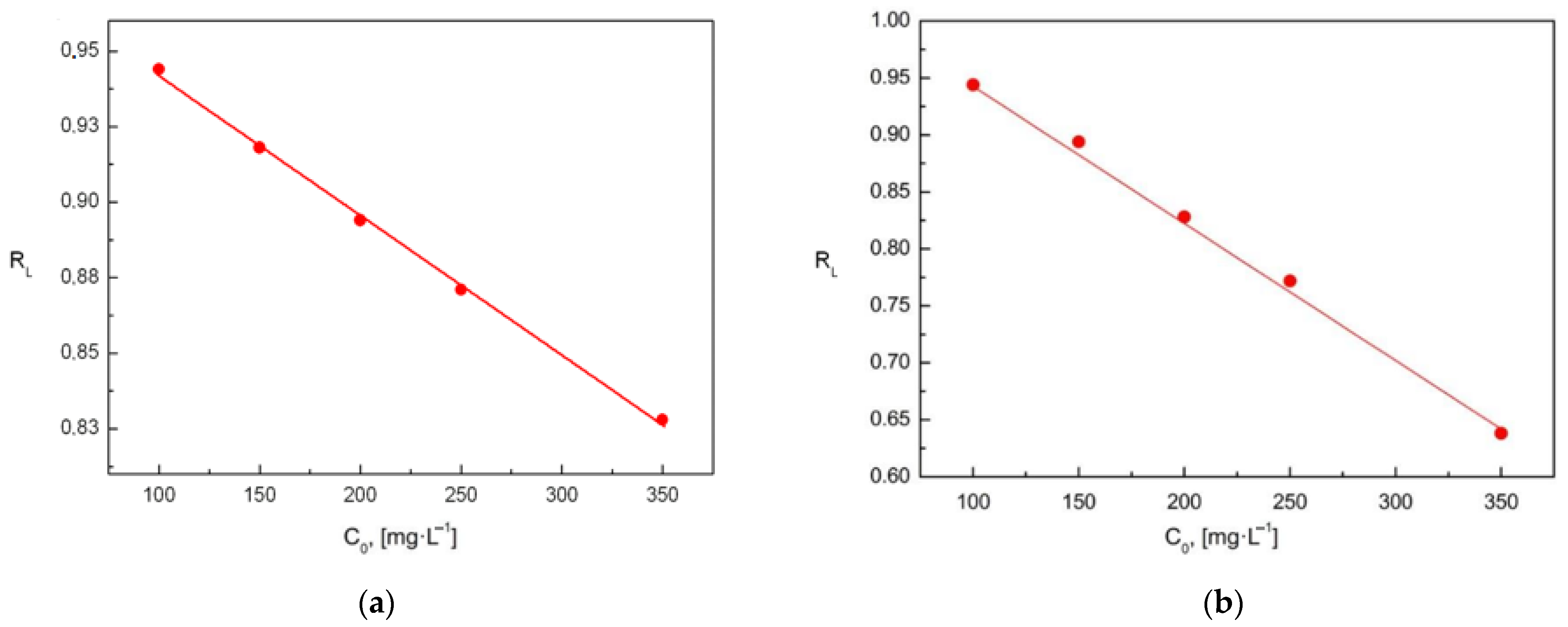
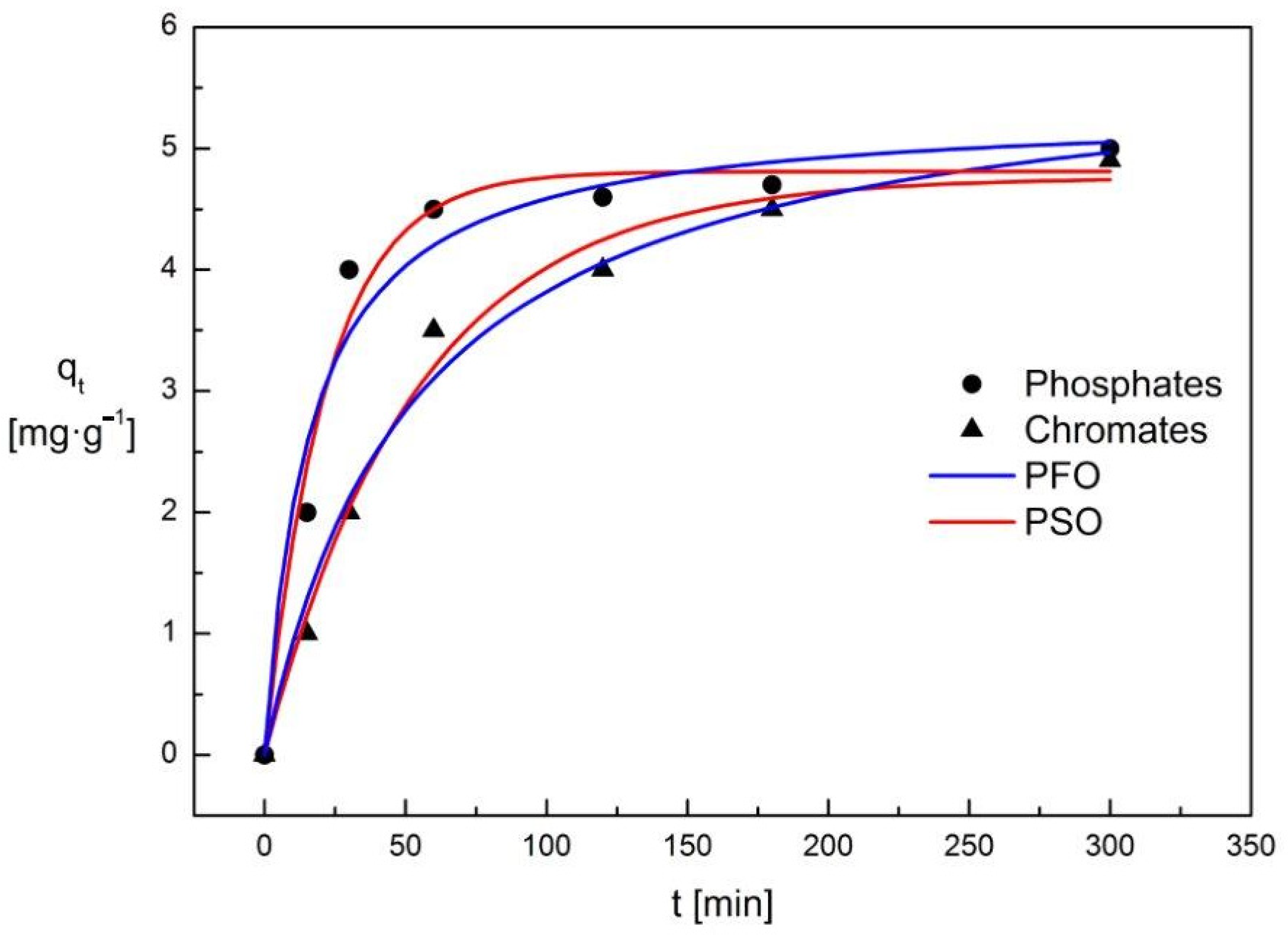
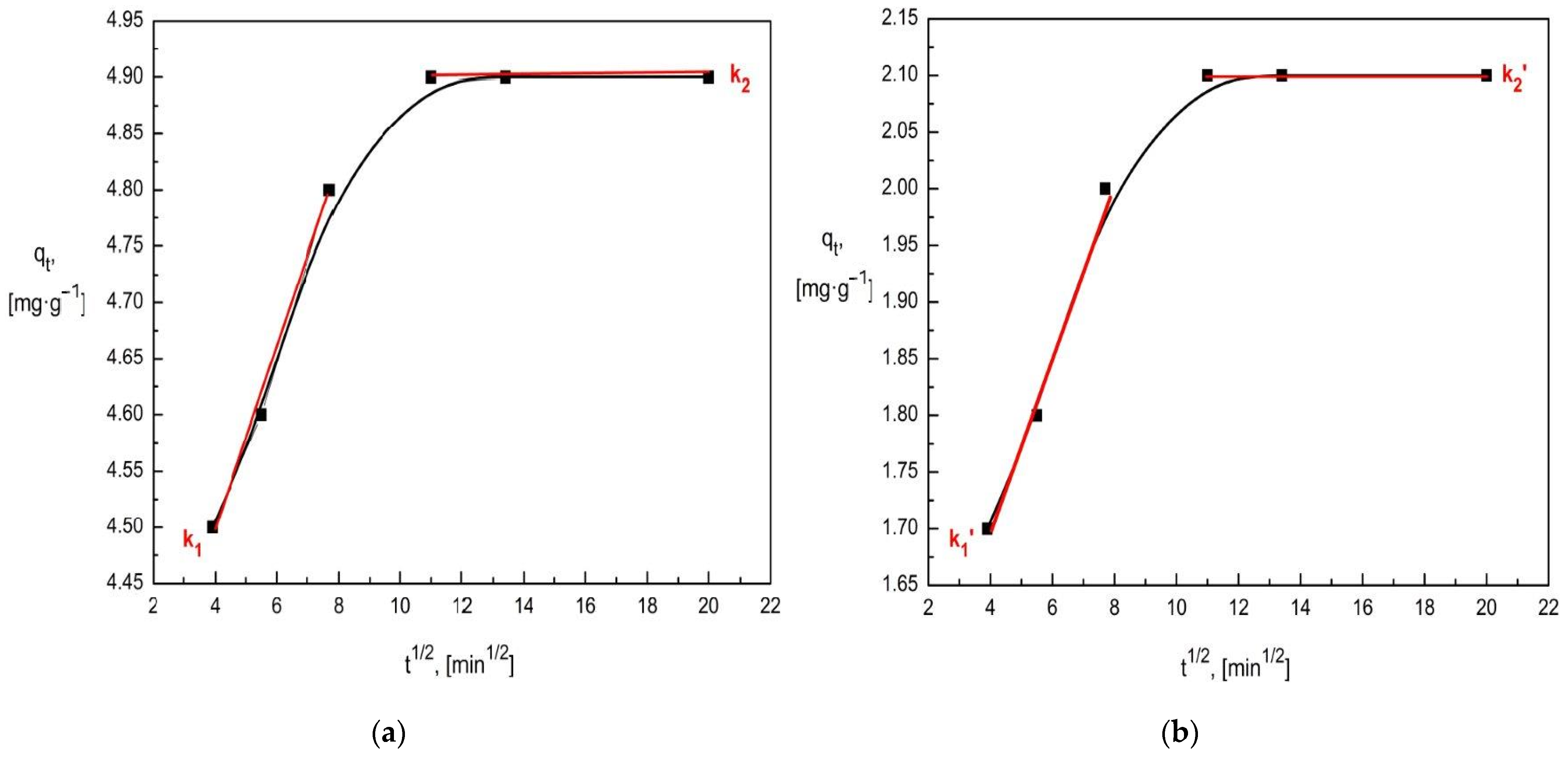
| Parameter | Value | Parameter | Value |
|---|---|---|---|
| SiO2, % (w/w) | 75 | MgO, % (w/w) | 2 |
| Al2O3, % (w/w) | 7 | K2O + Na2O, % (w/w) | 2 |
| Fe2O3, % (w/w) | 9 | Residue on ignition (1025 °C), % (w/w) | 2 |
| TiO2, % (w/w) | 1 | Weight density, g/mL | 2.3 |
| MnO2, % (w/w) | 1 | pH (10% suspended solids) | 5.5 |
| CaO, % (w/w) | 1 | Bulk density, g/L | 509 |
| Isotherms | Equation | Abbreviations | References |
|---|---|---|---|
| Freundlich | qe—the equilibrium concentration of the adsorbate on the adsorbent surface [mg·g−1], KF—Freundlich adsorption equilibrium constant [mg1−1/n·L1/n·g−1], Ce—the concentration of the adsorbate in the solution at equilibrium [mg·L−1], n—adsorption intensity, qmax—maximum adsorption capacity [mg·g−1], KL—Langmuir adsorption equilibrium constant [L·mg−1], aR—Redlich-Peterson constant [L·mg−1]βR, KR—Redlich-Peterson adsorption equilibrium constant [L·g−1], βR—parameter dependent on the concentration of the adsorbate, KJ—Jovanovich adsorption equilibrium constant [L·g−1], KH—Halsey adsorption equilibrium constant [mgn+1·g−1·L−1]. | [64,65] | |
| Langmuir | [65,66,67] | ||
| Jovanovich | [68] | ||
| Halsey | [69,70] | ||
| Redlich-Peterson | [64,65,66,67] |
| Kinetic Model | Pseudo-First-Order (PFO) | Pseudo-Second-Order (PSO) | Intra-Particle Diffusion |
|---|---|---|---|
| Equation | dq/dt = k1(qe − qt) qt = qe(1 − e−k1t) | dq/dt = k2(qe − qt)2 qt = k2qe2t/(1 + k2qet) | qt = kit1/2 + bi |
| where: qt—adsorption capacity (in time t) [mg·g−1], ki—the intra-particle diffusion rate constant for adsorption [mg·g−1·min1/2], bi—the boundary layer thickness [mg·g−1]. | |||
| Sample | Crystallite Size, Å | Crystallinity, % | Amorphous, % |
|---|---|---|---|
| AP | 342 | 66.6 | 33.4 |
| AP + chromates ions | 552 | 66.0 | 34.0 |
| AP + phosphates ions | 408 | 68.6 | 31.4 |
| Wavelength, [cm−1] | Band Description | The Band Comes from: |
|---|---|---|
| 3443 | Very wide, high intensity | the stretching vibrations of the –OH group. |
| 1643 | Narrow, low intensity | the stretching vibrations of the groups: C=C, CO-CH2-CO |
| 1386 | Very narrow, low intensity | the adsorbed PO34− ion |
| 1076 | Broad, high intensity | the stretching vibrations of the C-O groups |
| 796 | Narrow, low intensity | the stretching vibrations of asymmetric C-H groups; band located in the dactyloscopy area |
| Parameter | ∆E1 | ∆Emax | ∆E2 | pH0.8 * |
|---|---|---|---|---|
| Value | 63.4 mV | 52.8 mV | 43.4 mV | 5.9 |
| Phosphates Ions | Chromates Ions | ||||||||
|---|---|---|---|---|---|---|---|---|---|
| Halsey isotherm | |||||||||
| KH [mgn+1·g−1·L−1] | n | R2 | X2/DoF | KH [mgn+1·g−1·L−1] | n | R2 | X2/DoF | ||
| 4·10−5 | 2·10−5 | <0.1 | 520 | 8·10−4 | 1.2·10−4 | <0.1 | 4320 | ||
| Jovanovich isotherm | |||||||||
| KJ [L·mg−1] | qmax [mg·g−1] | R2 | X2/DoF | KJ [L·mg−1] | qmax [mg·g−1] | R2 | X2/DoF | ||
| 0.008 | 27.2 | 0.839 | 24.1 | 0.048 | 85.6 | 0.886 | 213 | ||
| Langmuir isotherm | |||||||||
| KL [L·mg−1] | qmax [mg·g−1] | R2 | X2/DoF | KL [L·mg−1] | qmax [mg·g−1] | R2 | X2/DoF | ||
| 0.013 | 28.9 | 0.889 | 16.6 | 0.079 | 87.3 | 0.908 | 173 | ||
| Freundlich isotherm | |||||||||
| KF [mg1−1/n·L1/n·g−1] | n | R2 | X2/DoF | KF [mg1−1/n·L1/n·g−1] | n | R2 | X2/DoF | ||
| 6.2 | 4.9 | 0.994 | 0.94 | 17.0 | 4.2 | 0.963 | 69.1 | ||
| Redlich-Peterson isotherm | |||||||||
| KRP [L·g−1] | aRP [L·mg−1] | B | R2 | X2/DoF | KRP [L·g−1] | aRP [L·mg−1] | B | R2 | X2/DoF |
| 255 | 40.3 | 0.8 | 0.994 | 1.12 | 29.7 | 1.13 | 0.8 | 0.975 | 55.2 |
| Material | Maximal Adsorption Capacity, mg/g | Ref. | |
|---|---|---|---|
| P | diatomite | 0.46 mg P/g | [37] |
| diatomite | 0.60 mg P/g | [28] | |
| diatomite | 3.51 mg P/g | [27] | |
| hydrous Fe oxide modified diatomite | 5–25 mg P/g | [28] | |
| diatomite coated by Fe0 and Fe oxides | 37.0 mg P/g | [27] | |
| La oxide modified diatomite | 58.7 mg P/g | [77] | |
| Absodan Plus | 9.46 mg P/g | present study | |
| Cr | calcined diatomite | 0.20 mg Cr/g | [47] |
| diatomite | 0.12 mg Cr/g | [75] | |
| Fe oxide modified diatomite | 6.10 mg Cr/g | [47] | |
| diatomite-MCM-41 composite | 70.9 mg Cr/g | [50] | |
| Absodan Plus | 39.1 mg Cr/g | present study |
| Parameter | Pseudo-First-Order (PFO) | Pseudo-Second-Order (PSO) | ||
|---|---|---|---|---|
| Phosphates Ions | Chromates Ions | Phosphates Ions | Chromates Ions | |
| χ2/DoF | 0.26 | 0.18 | 0.06 | 0.02 |
| R2 | 0.953 | 0.979 | 0.989 | 0.993 |
| k1 [min−1] | 1.3·10−2 | 2.8·10−3 | 4.8·10−2 | 2.1·10−2 |
| qe [mg·g−1] | 5.5 | 5.7 | 4.2 | 4.9 |
| The Type of the Process | Line Equation | The Value of the Diffusion Rate Constant [mg/g·min1/2] |
|---|---|---|
| Boundary layer diffusion for chromates ions | ||
| Intraparticle diffusion for chromates ions | ||
| Boundary layer diffusion for phosphates ions | ||
| Intraparticle diffusion for phosphate ions |
Publisher’s Note: MDPI stays neutral with regard to jurisdictional claims in published maps and institutional affiliations. |
© 2022 by the authors. Licensee MDPI, Basel, Switzerland. This article is an open access article distributed under the terms and conditions of the Creative Commons Attribution (CC BY) license (https://creativecommons.org/licenses/by/4.0/).
Share and Cite
Sočo, E.; Domoń, A.; Papciak, D.; Michel, M.M.; Cieniek, B.; Pająk, D. Characteristics of the Properties of Absodan Plus Sorbent and Its Ability to Remove Phosphates and Chromates from Aqueous Solutions. Materials 2022, 15, 3540. https://doi.org/10.3390/ma15103540
Sočo E, Domoń A, Papciak D, Michel MM, Cieniek B, Pająk D. Characteristics of the Properties of Absodan Plus Sorbent and Its Ability to Remove Phosphates and Chromates from Aqueous Solutions. Materials. 2022; 15(10):3540. https://doi.org/10.3390/ma15103540
Chicago/Turabian StyleSočo, Eleonora, Andżelika Domoń, Dorota Papciak, Magdalena M. Michel, Bogumił Cieniek, and Dariusz Pająk. 2022. "Characteristics of the Properties of Absodan Plus Sorbent and Its Ability to Remove Phosphates and Chromates from Aqueous Solutions" Materials 15, no. 10: 3540. https://doi.org/10.3390/ma15103540
APA StyleSočo, E., Domoń, A., Papciak, D., Michel, M. M., Cieniek, B., & Pająk, D. (2022). Characteristics of the Properties of Absodan Plus Sorbent and Its Ability to Remove Phosphates and Chromates from Aqueous Solutions. Materials, 15(10), 3540. https://doi.org/10.3390/ma15103540










